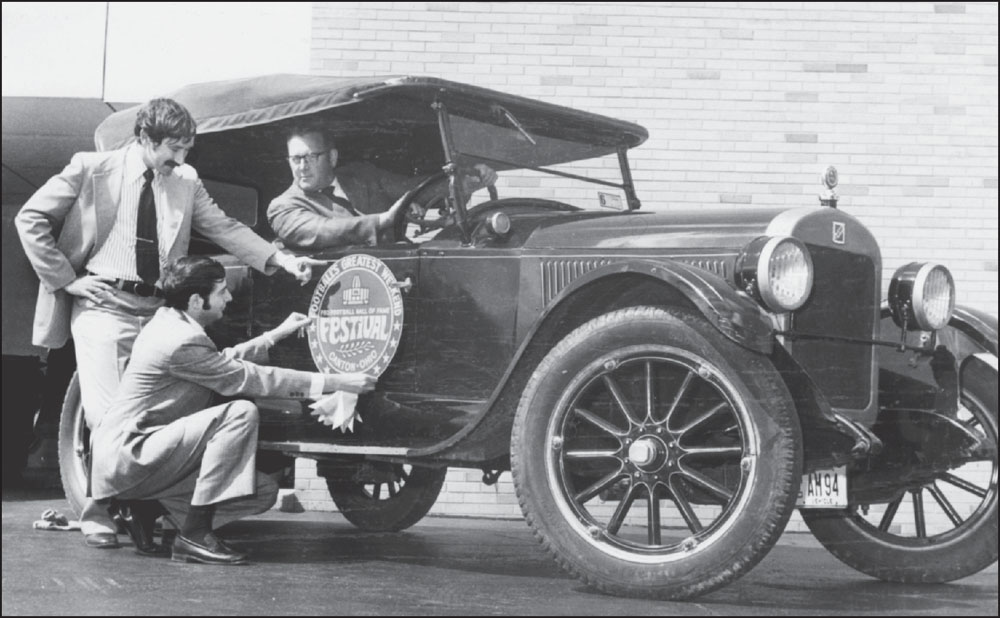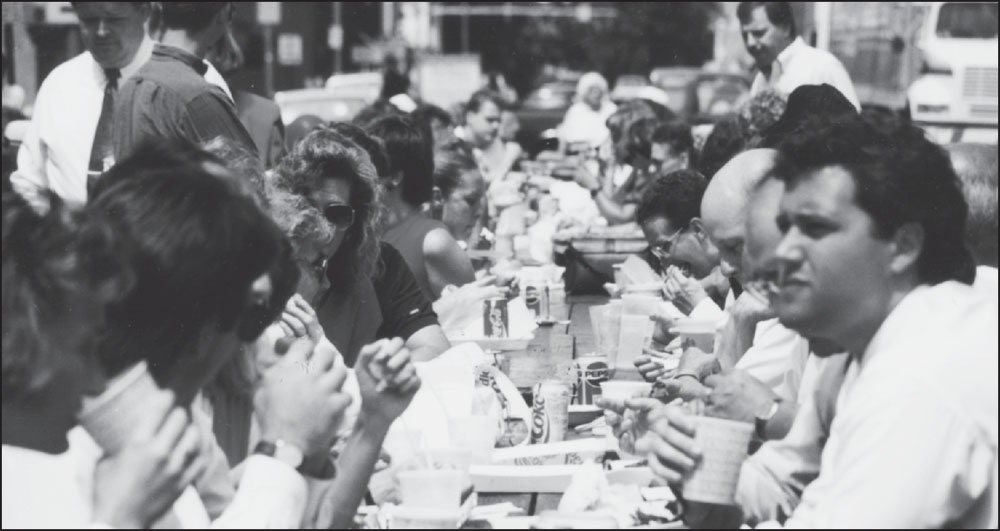Nine
SPORTS

The first local professional baseball teams in Canton played from 1887 to 1888 and in 1892 in the Ohio State League. Over the years, Canton teams have been part of the Tri-State League, Central League, Ohio-Pennsylvania League, Inter-State League, Buckeye League, and Middle Atlantic League, according to James P. Holl, author of The Canton Terriers. This unidentified Canton team is likely from one of the earliest ball clubs in the late 19th century.

The Pennsylvania Railroad team, pictured here in 1920, likely played at the new Meyer’s Lakeside Athletic Park, built on the site of the old League Park. The facility hosted professional football games as well as sandlot baseball teams. Canton’s last professional baseball team played at Lakeside from 1936 to 1942. Walter Lash won the team’s naming contest with “Canton Terriers,” noting that terriers are “scrappy, alert and full of pep,” and the designation was chosen to parallel the football team, the Bulldogs.

In 1903, A.J. Dysle operated the Grand Bowling Alleys at 125 East Eighth Street (which became Third Street SE when the downtown streets were renumbered in 1913). Acme Bowling Alley & Pool Parlor was located at Third and Market Streets in the Martin Block. In October 1907, the City Bowling League had eight teams—the Tabernacles, Grands, Acmes, Simpsons, Stetsons, Athletics, Hardly Ables, and Entre Nous. The bowlers in this photograph are unidentified.

This photograph was taken at Canton Recreation Lanes in the 1940s. Pictured from left to right are (first row) Elmer, Evelyn, Eva, and Ed Stuckey; (second row) Cora and Helen Stuckey. By 1943, Canton boasted 11 bowling alleys and more than 600 teams sanctioned by the American Bowling Congress. In the 1950s, bowling expanded nationwide with the invention of the automatic pinsetter and national television coverage of bowling tournaments. (Courtesy of Linda Todd.)

Located at Meyers Lake, the Lakeside Country Club opened one of the earliest golf courses in Canton in the spring of 1903. This postcard shows the locker house and ninth green of the nine-hole course, designed by Tom Bendelow. Today, Stark County is known as “Ohio’s Golf Capital” because there are 21 golf courses within its borders. Canton has five public golf courses—Glenmoor Country Club, Meadowlake Golf & Swim, Skyland Pines Golf Club, Tam O’Shanter Golf Course, and the Quarry Golf Club. East Canton is the home of Clearview Golf Club, the first course designed, built, owned, and operated by an African American.

In 1906, the team pictured here won Canton’s city championship in roller polo, which was a game similar to hockey but played on roller skates and with a round ball rather than a puck. The team was sponsored by a cigar-making company in town and was made up of young men from the “Limerick” neighborhood in Canton’s southwest section. Local roller polo teams played each other at the Auditorium. Pictured here from left to right are (first row) Kidder Baxter, team manager Fred Bellinski, and Leo Fisher; (second row) William Burnosky, Claude Feightner, and Albert Elkins.

Canton’s first professional football team, the Athletics, was coached by William L. Day, son of William R. Day. He used home talent in combination with semiprofessional or strictly amateur players. In 1904, the team started securing college players for weekend games, and Coach Day organized the Canton Athletic Club to help fund Canton’s football, baseball, and basketball teams. In 1906, the Athletics became the Bulldogs. The rivalry between Canton and the Massillon Tigers was in full swing by then, with both communities supporting the teams financially and packing the stands for games.

After a nine-year hiatus, professional football returned to Canton in 1915 when Ray McGregor and Ben Clark started another team. According to Stark County historian E.T. Heald, the Canton-Massillon games in this new era were “hard fought and fairly played.” Jim Thorpe came to town that year to play in two games with the Bulldogs. By this time, most of the home talent had been replaced by imported players from around the country. The venerable Thorpe led the Canton Bulldogs to their first World Championship in 1919.

The Canton Bulldogs won back-to-back world championships in 1922 and 1923. After the 1923 season ended, the team was bought out and moved to Cleveland.

The rivalry between the McKinley Bulldogs and the Massillon Tigers that still exists today began with the professional football teams. The high school teams adopted those names after the professional teams left for larger cities in the 1920s.

Judy Hively, Barb Nicholson, and Betty McCauley stand by a car decorated for the 1961 Massillon-McKinley game. After the departure of the professional teams, high school football quickly became a major pastime for both communities. Yearly matches between the rival teams have attracted large audiences and captured the attention of almost everyone in town for nearly a century. Today, the annual Massillon-McKinley game is a nationally recognized event in high school football. (Courtesy of Linda Todd.)

In 1935, Canton lost a beloved civic leader when John A. Fawcett died of pneumonia. Fawcett was the president of the First Trust & Savings Bank and an avid McKinley Bulldogs fan. The John A. Fawcett Stadium opened in 1938. The McKinley Bulldogs played the Lehman Polar Bears in the first game at the stadium, which had seating capacity for 20,000. Official opening ceremonies took place the following year when the $250,000 project was completed.

In 1920, the Professional Football League was formed in Ralph Hay’s Hupmobile dealership at Cleveland Avenue and Second Street SW in Canton. Hay owned the Canton Bulldogs. The objectives were to unify scattered teams, prevent contract jumping, and regulate the sport’s rules. Since Canton was the home of the first organized professional football league, it was an ideal location for the Pro Football Hall of Fame. Construction on the new museum began in 1962.

From the beginning, the Pro Football Hall of Fame has sponsored an elaborate grand parade to celebrate the enshrinees. This photograph, featuring the Massillon Tigers mascot, was taken during the first parade in 1963. (Courtesy of Linda Todd.)

Each parade features floats, marching bands, and other units, such as the antique automobile shown in this photograph from the 1977 event. Enshrinees past and present ride in convertibles with their names displayed on the side. The original enshrinement gallery was designed for 34 individual tributes to be chosen by the sports media, with an annual induction size of two or three players as in the Baseball Hall of Fame. It would have been adequate for at least two decades, if the charter class had not consisted of 17 players. Over the years, there have been several expansion projects to accommodate the growing museum.

Brothers Guy Walter (left) and Gary Walter (right) were thrilled when their favorite teams came to town for the 1979 Hall of Fame game. Hall of Fame founders pitched the idea of a Hall of Fame game, modeled after the one held annually at the Baseball Hall of Fame, and the National Football League loved the idea. It was decided that teams from outside Ohio should play in the first game, so the New York Giants and St. Louis Cardinals were invited to Canton. They played to a 21-21 tie. (Courtesy of Dawn Walter.)

Community volunteers and Hall of Fame officials work together to organize the annual Hall of Fame Festival, drawing thousands of visitors from across the country during the two weeks leading up to the enshrinement. In addition to the Grand Parade, the Hall of Fame Festival includes a fashion-show luncheon, two- and five-mile running races, fireworks, a concert, a food festival, and a hot air–balloon classic. The three-day ribs burn-off, shown here, was originally staged in downtown Canton but was moved to the Stark County Fairgrounds in 2003. (Courtesy of Dick Fulton.)
















